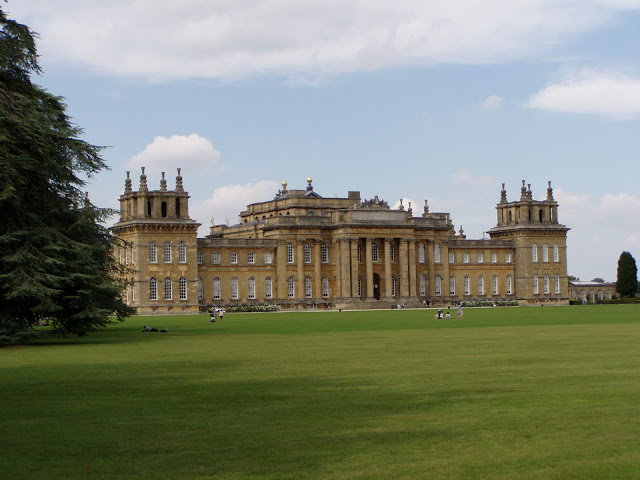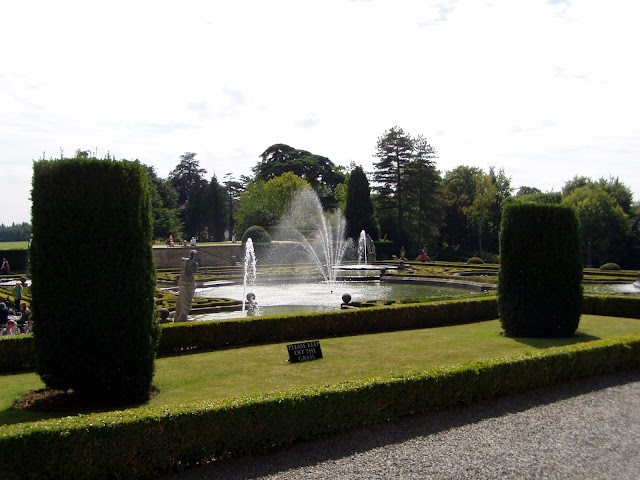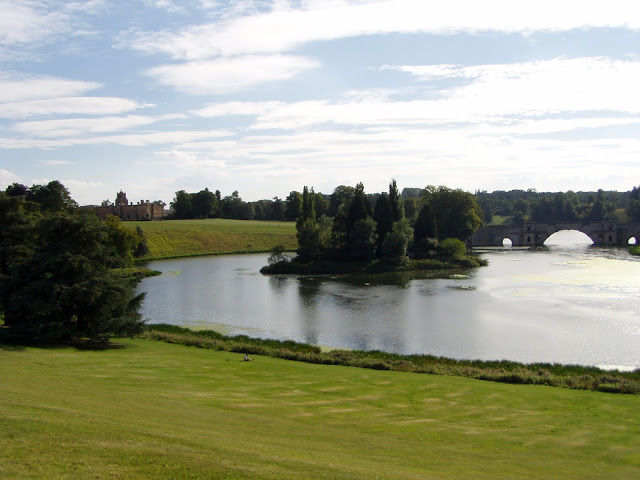19 August 2011
Blenheim Palace has always intrigued me, and so one August weekend C and I decided to make a trip up to Oxford and spend the day exploring the estate.
Growing up, it had been one of the few English castles I knew about, my grandmother possessing one of the guidebooks from her own visits there years earlier.
And in later years I stumbled upon it again when researching the life of Queen Anne. Whilst at Uni, I had written an essay on the Queen Regnants in English History, one of whom was Queen Anne Stuart. While she isn't remembered as being that remarkable, her friendship with Sarah Churchill nee Jennings, 1st Duchess of Marlborough was highly memorable.
And in later years I stumbled upon it again when researching the life of Queen Anne. Whilst at Uni, I had written an essay on the Queen Regnants in English History, one of whom was Queen Anne Stuart. While she isn't remembered as being that remarkable, her friendship with Sarah Churchill nee Jennings, 1st Duchess of Marlborough was highly memorable.
However what was even more entertaining was how markedly different these historical references to her were from the depiction of her in the Blenheim Palace guidebook.
 |
| Photo from C |
I also suspect that she is the type of person who only saw events as they affected her, allowing for a different reading of her surviving writings.
This is how she shines through in the history of Anne, written by historians who are usually as unsympathetic towards Anne.
I don't know whether it is just me, but I always found there to be something telling in her portraits. Though the pose is a typical one, the angle of the incline of Sarah head seemed to sway more towards self-assurance and pride than the coy beguiling look of other portraits of the era.
However in the Blenheim Palace guidebook, Sarah is placed in a far more flattering light. The reason for this is almost certainly that Blenheim Palace still belongs to Sarah's descendants and they're unlikely to want to portray her, warts and all, instead preferring to focus on the drive and tenacity which saw her built the monumental Blenheim Palace and found a dynasty that still survives to this day.
 |
| And that's just the front door. |
Sarah and Anne had been friends from a young age and despite the different directions of their lives were inseparable; whenever they were apart they would write to each other as Mrs Freeman (Sarah) and Mrs Morley (Anne).
 |
| Photo from C |
 |
| Photo from C |

Upon Anne's marriage, Sarah was a natural inclusion into Anne's new household, being given the most important position available. This increased again upon Anne's ascension to the throne, with Sarah being given a string of titles including Mistress of the Robes (the highest female office at court).
It soon became widely known at court that Sarah 'exerted great influence over [Anne] on both personal and political levels' to the extent that she caused a permanent rift between Anne and her sister Queen Mary II.
 |
| Photo from C |
While Anne valued that Sarah was indifferent to rank and told her exactly what she thought, Sarah was not good at simply expressing her opinion. In their youth Anne had valued the direction Sarah offered however once she became Queen, Sarah continued to behave as though she could direct Anne's life, government and country. She continually berated Anne for the way she ran her household, the political, court and church appointments she made and even her choice in attire. The one thing she did not offer was the kindness and compassion that Anne expected from her closest friend.
This self-serving behaviour, combined with Sarah's insensitivity towards Anne's feelings (particularly when her husband died), did her no favours and ultimately resulted to their friendship cooling and Sarah being dismissed from court. While this could be attributed to a growth in the personalities of the two women and their growth away from each other, I find the fact that Anne was not the only person with whom Sarah fell out, spectacularly, rather telling. Sarah fell out with her eldest daughter the 2nd Duchess of Marlborough, the architect of Blenheim, King George II and his wife Caroline, and Prime Minister Robert Walpole.
It didn't help that Sarah's husband John Churchill was one of Anne's best commanders, and that public knowledge of Anne's conflict with Sarah could negatively affect his authority on the field. In thanks for his efforts Anne had raised him from Earl to Duke of Marlborough and enabled him to begin the construction of a Ducal house worthy of his achievements, ambitions and name. After all, this national hero needed a suitable home.
 |
| Photo from C |

Unfortunately, despite the honour of this bequest, it lead to even more strife between Anne and her friend. The reason is that accounts appear to differ on what exactly Anne awarded the Churchills.
Most accounts indicate that it was to be a set sum of money to go towards the building of Blenheim Palace. Indeed Parliament voted to give funds for the construction to the Churchills but there appears to be no record that they fixed upon an amount or decided upon a course of action should the project run over budget.
However, according to Sarah, Anne had awarded them the entire cost of the new Ducal house, and she was furious when Anne 'reneged' on her promise. What I believe is more likely is that she was annoyed that Anne had become resilient to her bullying and could not be swayed to absorb more of the ever increasing costs Sarah was incurring.
 |
| Photo from C |

What is also interesting is that Sarah believed that Anne had promised to pay for the construction of Blenheim Palace in its entirety. If this Ducal residence was on the scale of a normal Ducal residence this belief is somewhat plausible.

 |
| Photo from C |

Sarah's strong personality shines out again in the records of the construction of Blenheim Palace.
Originally the gift of land for the small insignificant Manor of Woodstock situated within a deer park.
It soon became an opulent and awe-inspiring building that seemed to stretch up to the sky and out in all directions. I remember wandering into one of the small courtyards and being impressed, only to be completely blown away by the central courtyard when we reached that.
In the process of this conversion, Sarah managed to argue with the architect/designer Sir John Vanburgh to the extent that he was banned from the site.


However, given that the architect was not Sarah's choice (she preferred Christopher Wren), but had instead been chosen by her husband without her consultation, it is fair to say that Sarah was not entirely thrilled with his appointment and would not have been as charming as she could otherwise be.
In fact, she is recorded as heaping criticism upon him and his designs, something that probably did not contribute to the security of his appointment, particularly as the source of the funding for his design had still not been sufficiently resolved.
In fact, she is recorded as heaping criticism upon him and his designs, something that probably did not contribute to the security of his appointment, particularly as the source of the funding for his design had still not been sufficiently resolved.
Whether the excessive majesty of the design was Vanburgh's or Sarah's idea, it's hard to say definitively, though it is not out of proportion for a woman who did everything within her power to ensure her husband received every possible benefit and accolade he could. In her eyes, this was probably a very fitting home for him and tribute to his achievements. It is just a pity that he did not live long enough to enjoy it fully.
As for C and I, we found that Sarah Churchill's hard work (and Consuelo's dowry*) made for a very enjoyable day trip.
*that's another story entirely.
























No comments:
Post a Comment